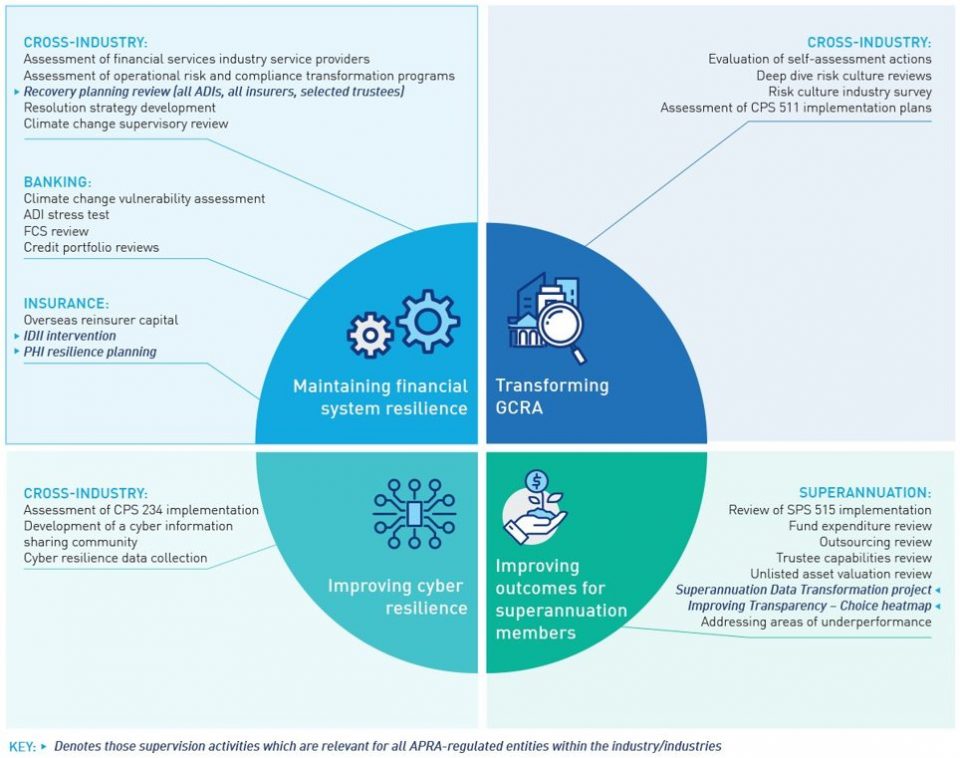
An overview of APRA supervision priorities for 2021 and 2022
After assessing the Australian Prudential Regulation Authority’s (APRA) policy priorities for 2021 and 2022, the Actuaries Institute’s Public Policy Team turn their attention to APRA’s supervision priorities for the next two years.
APRA has recently updated it’s policy and supervision priorities for 2021 and into 2022, aligned to APRA’s long term strategy and responding to external drivers, including changes to remuneration standards, Basel III bank capital reforms, implementation of AASB 17, supporting the Financial Accountability regime (FAR), and Your Future, Your Super reforms.
Refer to our recent Actuaries Digital article reviewing APRA’s policy priorities for 2021.
2021/22 Supervision Priorities
APRA will continue to review prudential supervision to minimise the regulatory burden and help regulated entities respond to the impact of COVID-19 and strengthen the financial system, and aid economic recovery.
APRA’s supervision priorities for 2021 align with the policy priorities: 1. maintain financial system resilience; 2. improve outcomes for superannuation members; 3. transform governance, risk culture, remuneration and accountability (GCRA) across all regulated entities; and 4 improve cyber resilience across the financial system.
Transition to the SRI Model
APRA will replace the Probability and Impact Rating Systems (PAIRS) and the Supervisory Oversight and Response System (SOARS) before 30 June 2021 with the new Supervision and Risk Intensity (SRI) Model. The SRI stage and tier of each regulated entity will remain confidential, consistent with APRA’s previous risk assessment system. The new model elevates non-financial risks and retains the importance of financial resilience.
The introduction of APRA Connect for data collection in 2021 will enhance APRA’s supervision capability.
Key priorities are summarised in the figure below from APRA’s Information Paper.

Cross Industry supervision priorities for 2021
Maintain financial system resilience
APRA remains alert to changes in economic, financial, and health conditions and over the next 12-18 months and will continue supervision of regulated entities and regular stress testing.
Operational resilience was APRA’s key focus area in 2020 and will remain a priority for 2021.
Operational resilience standards and guidance notes will be updated. Supervision activities will focus on 1. the impact of changes made to entities’ operations in response to the pandemic and the effectiveness of existing contingency arrangements to protect against any risks that may have arisen; 2. the extent to which regulated entities’ risk profiles reflect changes to business practices and strategy as a result of COVID-19, and any operational risk losses; and 3. assessment of the range and concentration of service providers used by APRA-regulated entities.
APRA will release a compliance risk management information paper in 2021 to drive further improvements.
Stress testing will continue and will include regulator-led common scenario stress tests and targeted stress test activities for entities undertaking their Internal Capital Adequacy Assessment Process.
Stress testing for the insurance industry will continue, and increased stress testing of the superannuation industry, at both the entity and industry level, will advance in 2021.
Improve cyber resilience
Cyber resilience is a major strategic focus, underpinned by APRA’s 2020-2024 Cyber Security Strategy. Over the next 12-18 months, APRA will: 1. Pilot a small group of entities to engage independent auditors to assess compliance with Prudential Standard CPS 234 Information Security to identify and address weakness in cyber practices; 2. Continue collection of cyber resilience data to generate cross-industry insights to be shared with regulators; 3. Pilot a cyber information-sharing community to improve awareness and share technical information; and 4. (in concert with the Council of Financial Regulators, CFR) test cyber resilience of Australia’s financial services industry via a pilot Cyber Operational Resilience Intelligence-led exercise.
Transform governance, risk culture, remuneration and accountability
APRA’s priorities include 1. An implementation review of sample entities for Prudential Standard CPS 511 Remuneration, 2. Continued risk culture deep dives at selected entities to evaluate responses to risk governance self-assessments and regular prudential engagement, and 3. Implementation of benchmarking to assess trends in risk culture following a risk culture survey to a pilot group. APRA will then work with Government to extend the accountability regime to all APRA-regulated industries.
Improve recovery and resolution capability
Stabilisation of the external environment in 2021 will enable APRA to refocus to release consultation on a draft cross-industry prudential standard on recovery and resolution planning (outlined in APRA’s Policy Priorities Paper).
Climate-related financial risks
APRA will continue to review entities capacity to manage and respond to climate risk and develop a climate risk guidance note with responses to the 2018 climate risk survey informing ongoing supervisory activities.
APRA is leading work on a climate vulnerability assessment (CVA) with the CFR. APRA recognises that large ADIs (Authorised Deposit-Taking Institutions) have made significant investments to improve their climate risk assessment and response capabilities, and where possible, the CVA will leverage this capability.
Insurance Supervision Priorities for 2021
APRA recognises that the insurance industry remains well-capitalised and responded well to the operational issues around COVID-19.
1. General Insurance
Business Interruption Insurance
Recovery and resolution planning for insurers remain APRA’s broad supervision priority as well as a focus on crisis readiness and managing risks associated with insurers high reliance on overseas reinsurance.
COVID-19 has highlighted the role of business interruption (BI) cover and the spotlight on the wording of business interruption policies. APRA is working with other regulators, industry, and broader stakeholders to achieve clarity. Changes around business interruption insurance will remain a focus for APRA to assess potential misalignment in coverage arising from pricing processes and the link between policy wordings and reinsurance.
Overseas reinsurance
APRA will continue to engage with insurers to understand the parent group’s capital management approach and capital support available to Australian reinsurers.
2. Life Insurance and friendly societies
COVID-19 elevated ongoing sustainability and profitability challenges. Regular stress testing exercises, new data collection and recovery planning will continue while the industry addresses these issues.
APRA will continue to intervene where it has concerns about the sustainability of an insurance product, particularly for Individual disability income insurance (IDII) products. APRA will continue to communicate with industry around the sustainability of insurance offered through superannuation funds.
Following the release of part I of APRA’s supervision roadmap of friendly societies in late 2020, APRA plans for other roadmap components to be released in the second half of 2021, including risk management, minimum capital requirements, and stress testing.
3. Private Health Insurance
APRA expects that economic impacts from COVID-19 will exacerbate sustainability challenges of rising premiums and declining membership in health insurance products. APRA expects industry participants to actively respond to these challenges, improving governance and controls around IT and outsourcing services.
Superannuation Supervision Priorities for 2021
Over the coming 12-18 months, APRA’s supervisory activities will focus on 1. Complete the review of unlisted asset valuation practices and engage with poorer performing entities to enhance their practices, 2. Review trustees implementation of requirements under Prudential Standard SPS 515 strategic planning and member outcomes (SPS 515) by examining business performance reviews and management of a range of expenditure items, 3. Supervise identified underperforming MySuper products, and where necessary, take enforcement action to require trustees to improve performance or transfer members to another product, 4. Complete the review of selected large trustees management of outsourcing providers, and 5. Build on APRA’s cross-industry GCRA initiatives to set clear expectation that trustees address actual and perceived barriers that hinder boards from achieving the optimal mix of skills and experience required to fulfil trustee obligations.
APRA will expand the Superannuation Data Transformation (SDT) program, releasing a response package in 2021. Trustees will be required to report under the new reporting standards in the second half of 2021. APRA will release a Choice Heatmap in the second half of 2021 for multi-asset class choice options and highlight underperformance areas in these products. Results from the Government’s performance test will be published under the Your Future, Your Super reforms.
Expanding recovery and resolution planning in the superannuation industry is also an important priority over the coming period and will help underpin the Government’s implementation of the Your Future, Your Super reforms.
Banking Supervision Priorities for 2021
APRA’s banking supervision priorities for 2021 focus on the key areas of credit risk, capital management and liquidity.
Further detail on APRA’s banking supervision priorities can be found here.
The complete paper of APRA’s Supervision Priorities can be found on APRA’s website.
CPD: Actuaries Institute Members can claim two CPD points for every hour of reading articles on Actuaries Digital.






